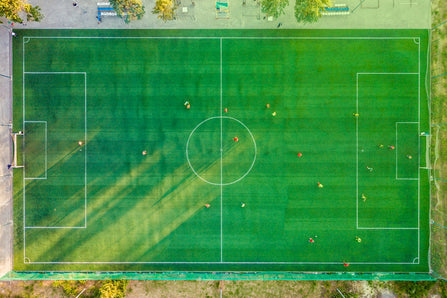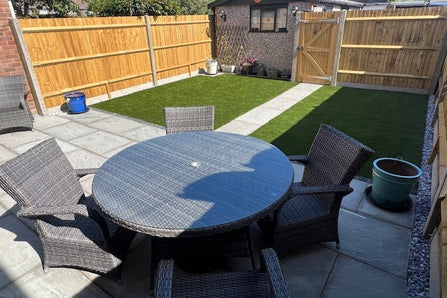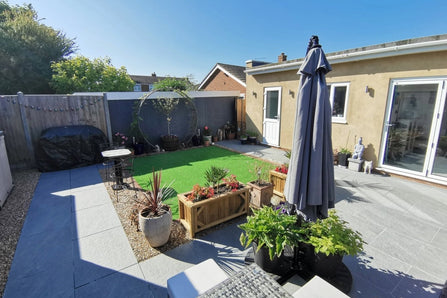The Complete Guide to Artificial Grass Infill: Why It Matters & How to Choose the Right One
Posted on by James Higgins
Artificial grass infill is a handy way of helping your artificial lawn last longer, feel soft underfoot, and look its best, with help from an additional material between the blades to support its structure and drainage. Infill can include sand, rubber, or other materials to keep the grass in place and support a more realistic look. Some artificial lawn varieties are designed to be used with infill, whereas others aren't, so it’s important to check before you decide.
If you’re buying your first home, considering a way to revamp your garden yourself, or looking at artificial grass installation professionals to landscape your outdoor area, this article will cover all you need to know about artificial grass infill materials, why it may be essential for some projects, and look at infill turf’s pros and cons vs non-infill artificial turf.
What is Artificial Grass Infill and Why Does It Matter?
Put simply, artificial grass infill is an extra ballast added on top to boost the look and performance of your faux turf. It can add an artificial lawn comfort layer, support the shape and direction of the blades, assist with artificial turf drainage and stability, help protect the lawn and its backing from damage, and encourage it to look and feel as natural as possible. If you’re seeking a simple way to boost your lawn’s longevity, overall appearance, and feel underfoot, infill may be the ideal solution.
The Role of Infill in Turf Performance

Artificial turf performance can be boosted with help from infill, which helps to improve artificial grass longevity, support, and stability. For sports surfaces, play areas, or gardens with heavy use, infill is often recommended, and it has the additional benefit of helping to protect the lawn from UV rays, too. Infill can help the surface to feel cushioned with better impact absorption, which can feel comfy underfoot as well as for children and pets playing.
Infill vs. Non-Infill Artificial Turf
Non-infill artificial turf does not have the additional sand or rubber protection material added on top, making it quicker and easier to install and, potentially, making maintenance simpler. However, the fibres can lie flatter, which may make the overall appearance look less realistic. Depending on the look you wish to create, and whether the area will be high traffic or just used occasionally, infill is an optional extra which may help your lawn to last longer. The disadvantages of using some types of infill is that it may clog the turf’s built-in drainage holes to increase water pooling, and some artificial grass infill sand can create additional mess which may stick to shoes and feet. Some products can sometimes be known to allow weeds to grow within it, bypassing your weed membrane layer, so it’s important to do your research first and consider product reviews and recommendations.
Key Benefits of Using Artificial Grass Infill in UK Gardens
Our low maintenance range of high performance artificial grass is built to look great year round and withstand the weather and regular use while avoiding damage from pets, pests, and children. By adding the right type of infill to your artificial grass, it can:
• Keep grass blades upright.
• Enhance cushioning and comfort.
• Improve drainage and reduce water build-up.
• Boost turf longevity.
• Guard against wear and tear and UV rays.
• Add to a natural feel and appearance.
Types of Artificial Grass Infill Explained
There are several common types of infill available, such as sand and rubber, alongside some newer, more innovative products, including Zeolite, cork, or coconut. It’s important to check whether the product, and your needs, requires it, as some artificial grasses are specifically manufactured for use without infill.
Silica Sand
This type of artificial grass infill sand is a popular choice, as it’s relatively inexpensive and has a strong track record in helping to maintain your lawn’s structure. Kiln dried silica sand is also fairly heavy, so can help to weigh down your artificial lawn, which may be beneficial if you have undulations. This type of sand usually helps to improve drainage and helps to support the blades’ structure effectively.
Rubber Infill
Rubber infill options are often preferred for sports surfaces and children’s play areas, as they can feel bouncy underfoot, and can make use of more environmentally conscious manufacturing and recycling procedures by repurposing old tyres. However, some people find that rubber infill can become too hot underfoot and for pets during the summer months.
Pet-Friendly and Odour-Control Infill
The best artificial grass infill for dogs and other pets is one which helps to control odours, support drainage, and provide a non-toxic outdoor surface for all the family to enjoy. Zeolite, which is considered a more pet-friendly infill, is ultra absorbent and helps to neutralise odours from pet urine or spilled drinks.
Specialty Coated Infill Options
There are other natural and synthetic substances to choose from when selecting the best infill for your lawn’s needs. From polymer-coated sand to cork, walnut shells, and coconut husk, there continues to be new innovations in this field which are supportive, durable, porous, and kinder to the environment. Our team will be happy to provide advice to help you find the best option for your outside space.
How to Choose the Right Infill for Your Needs
Whether or not you need infill will depend on the artificial grass that you choose, and from there your infill can be selected based on your needs, preferences, and plans for your new lawn.
Consider Usage: Family, Pets, or Light Use

Artificial grass infill for dogs, cats and other pets may benefit from selecting a natural option, which is easy to keep clean, drains effectively, and can help keep odours under control. Family lawns for light use and leisure will need less cushioning than sports areas or play zones, and if you want to avoid additional mess our team can advise you on which infill will be the simplest choice for keeping things neat.
Budget and Long-Term Value
Not all infills are created equal, and some have a higher price point to match. If you’re only looking at a smaller area, you may be able to stretch to a more high performance infill for the best results, but if you’re on a budget or treating a large area then a more purse-friendly option will help to balance preserving the look and feel of the grass without breaking the bank.
Installation and Maintenance Preferences
Some infills are easier to put down than others, and some require a little more maintenance, and patching up or replacing, over the years. If you’re short of time, a low-maintenance option may be the best choice to fit your lifestyle. By opting for artificial grass you’ll already be saving time by no longer having to cut, water, or fertilise your lawn, so it makes sense that most homeowners will want to keep infill maintenance to a minimum too.
DIY Tips: How to Install or Replace Artificial Grass Infill
If you’re wondering how to apply infill if you’re doing it yourself, here’s a simple guide to help you.
Tools You’ll Need:
- Measuring Tape
- Shovel
- Rake
- Wheelbarrow
- Hose
- Leaf blower or dustpan and brush
- Drop spreader
- Broom with stiff bristles
- Infill material
- PPE to protect your eyes, face and hands
Step-by-Step Process:
The steps below may vary with different materials, but as a general how-to guide you should:
- Measure the area after your artificial lawn is laid to calculate and select your infill material.
- Evenly spread the infill over the base and brush into the grass fibres. It’s recommended to use a drop spreader for easy and even distribution.
- Use a brush and/or rake across the lawn to make sure the infill is embedded between the blades. We recommend our Telescopic Artificial Grass Rake. This step can take a while, but be sure to go in different directions to ensure an even distribution.
- Go over any patchy areas, or try to cover any gaps where the infill isn’t visible.
- If possible, use a leaf blower or dustpan and brush to remove any excess infill which hasn’t embedded in the lawn.
- You may need to sweep your lawn again to ensure the blades are pointing the right way and your lawn is looking its best.
When to Top Up or Refresh Infill
Many experts recommend refreshing your artificial grass infill between every two to eight years to make sure it’s performing. High-traffic areas and longer blades tend to need their infill replenishing more often to maintain their aesthetic. You may start to see certain sections where the blades aren’t sitting in the right direction, or the whole lawn may start to feel flatter, more compact, and less comfortable or bouncy under foot. It’s possible to replenish all of the infill at once, or simply focus on patches where the infill may have worn away, using the same material.
Recommended Infill Options from Grass247
Grass247 is your expert, go-to source for garden DIY advice plus artificial grass and accessories knowledge. Browse our selection of realistic yet practical artificial turf today, whether you’re after an infill or non-infill lawn, and we recommend reading artificial grass infill UK reviews to help guide you. Don’t hesitate to contact our friendly team if you’d like some advice on infill materials and the best product for your needs.



